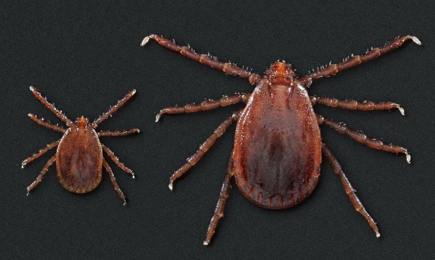Human bite leads to discovery of Asian longhorned ticks in New York
Asian longhorned ticks, which have been known to feed mainly on farm animals, particularly cattle, can transmit deadly diseases. In Asia, the longhorned ticks have infected humans with the potentially fatal disease SFTS (severe fever and thrombocytopenia syndrome). As of yet, no cases have been reported in the United States.
Study explores the risk of tick bites among German military personnel
Military personnel are at a particularly high risk of contracting a tick-borne disease, as they spend the majority of their time outdoors and in heavily forested areas. A new study, by Sammito and colleagues, looks at the risk of tick bites among individuals in the military stationed in northern Germany.
Neurological damage/dysfunction found in early Lyme disease patients
If Borrelia burgdorferi spirochete, the bacteria causing Lyme disease, can infect the brain and disrupt functioning of the central nervous system, it may also alter cerebral metabolism, suggests Garkowski and colleagues in the Journal of Neurology’s May 2019 issue.
Growing list of cardiac problems in Lyme disease
“Lyme disease affects all layers of the heart and every part of the conducting system,” writes Kannangara and colleagues in the journal BMC Infectious Diseases. [1] The authors came to this conclusion following treatment of a 37-year-old male with inducible heart block (HB).
Infected deer ticks moving into New York City
In 2017, New York City (NYC) health officials released an advisory, warning clinicians to be on alert for patients who may exhibit symptoms of a tick-borne disease. According to the notice, Staten Island, a borough of NYC, had a significant number of locally acquired Lyme disease cases. [1]
Getting the diagnosis correct and avoiding ‘anchor bias’
‘Anchor bias’ can occur when a doctor makes decisions based on the initial information (anchor) provided and in turn, misses the correct diagnosis. For example, a patient may be diagnosed with chronic fatigue syndrome, fibromyalgia, migraines or a mood disorder because the physician focused on the first information and missed the diagnosis of Lyme disease.
Article outrage: Lyme disease easily treated?
An article published in the New York Times entitled “My Son Got Lyme Disease. He’s Totally Fine. Horror stories about lingering Lyme disease proliferate, but the illness is easily treated,” has ignited outrage among Lyme disease patients and their families.
Should Lyme disease be added to the causes of vocal cord paralysis?
Country singer Shania Twain will soon be back on tour after battling Lyme disease, which caused her to lose her voice for several years. The singer underwent two extensive operations to her throat in hopes of regaining her voice. She tells Prevention magazine, “I had to have an operation that was very intense and it’s an open-throat operation, very different from a vocal cord operation.”
What does it take to be a “Lyme literate” doctor?
“A physician who is board certified in the specialty of infectious diseases surely is "Lyme literate" and should know how to diagnose and treat Lyme disease; the same is true for general practitioners in endemic areas with experience treating patients with Lyme disease,” writes Phillip J. Baker, PhD, executive director of the American Lyme Disease Foundation, in the American Journal of Medicine. [1]
Bourbon virus: flu drug to treat the deadly disease?
The Bourbon virus (BRBV), believed to be transmitted through tick or insect bites, was first identified in a Kansas man in 2014, who eventually died due to complications from the disease. And while only a handful of people have reportedly developed the virus, two have died from it.












